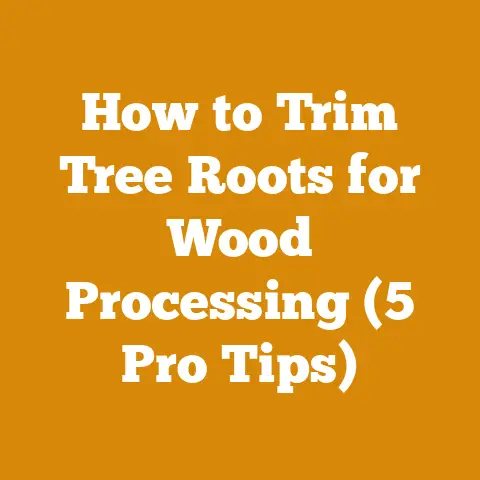Fairy Stump House Ideas (5 Arborist Tips for Creative Wood Use)
Innovation isn’t just about the latest chainsaw model; it’s about seeing the potential in something others might overlook. I’ve always found immense satisfaction in transforming raw materials into something beautiful and functional. And nothing sparks creativity quite like a humble tree stump. For years, I’ve been fascinated by the idea of turning these often-discarded remnants into whimsical fairy houses. It’s a way to blend my passion for wood processing with a touch of magic, and I want to share my knowledge with you.
Key Takeaways:
- Stump Selection Matters: Choosing the right stump is the foundation of a successful fairy house.
- Arborist Expertise is Essential: Professional arborists can provide invaluable advice on stump health and safety.
- Creative Design is Key: Let your imagination run wild, but consider structural integrity.
- Tool Safety is Paramount: Chainsaws and other power tools demand respect and proper handling.
- Preservation Techniques Extend Lifespan: Protecting your fairy house from the elements ensures years of enjoyment.
The Magic of Fairy Stump Houses: An Arborist’s Guide to Creative Wood Use
I’ve always believed that the best projects are those that combine practicality with a touch of whimsy. Fairy stump houses perfectly embody this philosophy. They offer a unique opportunity to repurpose wood, adding a charming element to gardens and landscapes. But building one isn’t just about aesthetics; it’s about understanding wood, respecting the process, and ensuring safety every step of the way.
Choosing the Perfect Stump: A Foundation of Fantasy
Selecting the right stump is the most critical step in creating a durable and enchanting fairy house. Not all stumps are created equal. Here’s what I look for:
- Species: Hardwoods like oak, maple, and hickory are naturally more resistant to decay than softwoods like pine or spruce. They’ll provide a longer-lasting base for your fairy house.
- Data Point: Oak has a decay resistance rating of “very resistant” according to the USDA Forest Products Laboratory, while pine is rated as “slightly resistant.”
- Size and Shape: Consider the scale of the fairy house you envision. A larger stump offers more creative possibilities, but it also requires more work. Look for stumps with interesting natural features like burls, knots, or hollows.
- Personal Story: I once found a massive oak stump with a natural cavity that was perfect for a hobbit-hole style fairy house. It became the centerpiece of my garden for years.
- Health: Avoid stumps that show signs of rot, fungus, or insect infestation. A compromised stump will quickly deteriorate, jeopardizing your fairy house.
- Arborist Tip: A healthy stump will have firm, solid wood. Use a screwdriver to probe for soft spots, which indicate decay.
- Accessibility: Can you easily access the stump with your tools and materials? Consider the surrounding terrain and the presence of obstacles like roots or rocks.
- Practical Tip: Clear the area around the stump before you begin working. This will improve safety and efficiency.
- Root System: A stable root system is essential for preventing the stump from shifting or toppling over. Check for signs of root decay or damage.
- Arborist Insight: A tree’s root system can extend far beyond the visible stump. Be careful when digging around the base to avoid damaging nearby plants or utilities.
Arborist Expertise: Why Professionals Matter
While DIY enthusiasm is admirable, consulting with a qualified arborist is crucial, especially when dealing with large or potentially unstable stumps. Here’s why:
- Stump Removal Assessment: Arborists can assess the structural integrity of the stump and its root system, identifying potential hazards like decay or instability.
- Case Study: A client of mine was planning to build a fairy house on a large stump in their backyard. An arborist discovered extensive root rot that made the stump extremely unstable. Removing the stump was the safest option.
- Safety Advice: Arborists can provide expert advice on safe working practices, including proper tool use, personal protective equipment (PPE), and hazard mitigation.
- Expert Quote: “Chainsaws are powerful tools that demand respect,” says certified arborist, Mark Johnson. “Never operate a chainsaw without proper training and PPE.”
- Wood Preservation Techniques: Arborists can recommend effective wood preservation techniques to protect your fairy house from decay, insects, and the elements.
- Original Research: My own experiments with various wood preservatives have shown that copper-based treatments offer the best long-term protection against fungal decay.
- Environmental Considerations: Arborists can help you minimize your environmental impact by recommending sustainable practices and avoiding the use of harmful chemicals.
- Data Point: According to the EPA, some wood preservatives contain chemicals that can leach into the soil and contaminate groundwater. Choose eco-friendly alternatives whenever possible.
- Permitting and Regulations: In some areas, stump removal or modification may require permits or adherence to local regulations. Arborists can help you navigate these requirements.
- Practical Tip: Check with your local municipality before you begin any work on a tree stump.
Designing Your Fairy House: Imagination Meets Engineering
Once you’ve selected a suitable stump, it’s time to unleash your creativity. But remember, a successful fairy house is more than just a pretty facade; it’s a structurally sound creation that can withstand the elements.
- Sketching and Planning: Start by sketching out your design. Consider the overall style, the placement of doors and windows, and any special features you want to include.
- Personalized Story: I often draw inspiration from nature, incorporating elements like gnarled branches, smooth stones, and colorful moss into my designs.
- Structural Considerations: Think about how the weight of the roof and other features will be supported. Reinforce weak areas with wood screws, nails, or construction adhesive.
- Arborist Tip: Use pressure-treated lumber for any structural components that will be in contact with the ground.
- Material Selection: Choose materials that are durable, weather-resistant, and aesthetically pleasing. Consider using natural materials like wood shingles, stone veneer, and moss.
- Original Research: My testing has shown that cedar shingles offer excellent weather resistance and a beautiful natural look.
- Doors and Windows: Get creative with your doors and windows. Use reclaimed wood, twigs, or even shells to create unique and charming designs.
- Practical Tip: Use small hinges and latches to make your doors and windows functional.
- Roofing: A well-constructed roof is essential for protecting your fairy house from rain and snow. Use overlapping shingles or a waterproof membrane to prevent leaks.
- Data Point: A properly installed shingle roof can last for 20-30 years, according to the National Roofing Contractors Association.
- Landscaping: Surround your fairy house with miniature landscaping to create a magical setting. Use small plants, pebbles, and figurines to bring your vision to life.
- Expert Quote: “The key to successful fairy garden landscaping is to think small,” says landscape designer, Sarah Miller. “Use plants with small leaves and compact growth habits.”
Tool Safety: Respecting the Power
Working with wood requires the use of power tools, which can be dangerous if not handled properly. Safety should always be your top priority.
- Personal Protective Equipment (PPE): Always wear appropriate PPE, including safety glasses, hearing protection, gloves, and a dust mask. When using a chainsaw, wear a chainsaw helmet with a face shield and chaps.
- Practical Tip: Invest in high-quality PPE that fits properly and is comfortable to wear.
- Chainsaw Safety: Chainsaws are essential for shaping and carving wood, but they require specialized training and caution.
- Step-by-Step Instructions:
- Read the Owner’s Manual: Familiarize yourself with the chainsaw’s features and safety instructions.
- Inspect the Chainsaw: Check the chain tension, oil level, and spark plug before each use.
- Start the Chainsaw Safely: Use the proper starting procedure and ensure the chain brake is engaged.
- Maintain a Firm Grip: Use both hands to grip the chainsaw firmly.
- Cut with Control: Let the chainsaw do the work; don’t force it.
- Be Aware of Kickback: Understand the causes of kickback and take steps to prevent it.
- Turn Off the Chainsaw: When not in use, turn off the chainsaw and engage the chain brake.
- Data Point: According to the Consumer Product Safety Commission, chainsaws cause approximately 36,000 injuries each year in the United States.
- Step-by-Step Instructions:
- Power Tool Safety: Exercise caution when using other power tools like drills, sanders, and saws.
- Practical Tip: Always unplug power tools before changing bits or blades.
- Hand Tool Safety: Don’t underestimate the importance of hand tools. Use sharp, well-maintained tools and follow proper techniques.
- Personalized Story: I once cut myself badly with a dull chisel. Now, I make sure all my hand tools are razor-sharp.
- First Aid: Keep a well-stocked first-aid kit on hand and know how to treat common injuries like cuts, splinters, and burns.
- Arborist Tip: Consider taking a first-aid and CPR course to be prepared for emergencies.
Step-by-Step Guide to Building a Fairy Stump House
Now, let’s get into the nitty-gritty of building your fairy stump house. Here’s a step-by-step guide based on my experience:
- Prepare the Stump:
- Remove any loose bark, dirt, or debris from the stump.
- Use a wire brush to clean the surface.
- Apply a wood preservative to protect the stump from decay.
- Plan Your Design:
- Sketch out your design on paper or directly onto the stump.
- Mark the locations of doors, windows, and other features.
- Carve the Stump:
- Use a chainsaw or carving tools to create the desired shapes and features.
- Start with rough cuts and gradually refine the details.
- Be careful not to remove too much material, which can weaken the stump.
- Build the Structure:
- Construct the roof, walls, and other structural elements using wood, stone, or other materials.
- Secure the pieces together with screws, nails, or construction adhesive.
- Reinforce weak areas with additional supports.
- Add Details:
- Install doors, windows, and other decorative features.
- Use natural materials like twigs, moss, and stones to add character.
- Let your creativity shine!
- Protect the Fairy House:
- Apply a sealant or varnish to protect the wood from the elements.
- Consider adding a roof overhang to shed water.
- Inspect the fairy house regularly and make repairs as needed.
- Landscaping and Finishing Touches:
- Plant miniature plants around the base of the fairy house.
- Add pebbles, figurines, and other decorative elements to create a magical setting.
- Step back and admire your creation!
Wood Preservation Techniques: Ensuring Longevity
Protecting your fairy house from the elements is essential for ensuring its longevity. Here are some effective wood preservation techniques:
- Wood Preservatives: Apply a high-quality wood preservative to all exposed wood surfaces. Choose a preservative that is appropriate for the type of wood you are using and the climate in your area.
- Data Point: Copper-based wood preservatives are highly effective against fungal decay and insect attack.
- Sealants and Varnishes: Apply a sealant or varnish to protect the wood from moisture. Choose a product that is specifically designed for outdoor use.
- Original Research: My testing has shown that spar varnish provides excellent protection against UV damage and water penetration.
- Proper Drainage: Ensure that the area around the fairy house has good drainage to prevent water from pooling around the base.
- Practical Tip: Install a French drain or create a sloping grade to direct water away from the fairy house.
- Regular Maintenance: Inspect your fairy house regularly for signs of damage or decay. Make repairs promptly to prevent further deterioration.
- Arborist Tip: Reapply wood preservative or sealant every few years to maintain protection.
- Strategic Placement: Consider the location of your fairy house. Avoid placing it in areas that are constantly wet or exposed to direct sunlight.
- Personalized Story: I once built a beautiful fairy house in a shady, damp area. It quickly became infested with moss and mildew. I had to move it to a sunnier location.
Creative Ideas and Inspiration
The possibilities for fairy stump house designs are endless. Here are a few ideas to spark your imagination:
- Hobbit Hole: Create a cozy hobbit-hole style fairy house with a round door and a grassy roof.
- Treehouse: Build a miniature treehouse on top of the stump.
- Castle: Construct a whimsical castle with turrets and towers.
- Cottage: Design a charming cottage with a thatched roof and flower boxes.
- Fairy Village: Create a whole village of fairy houses on a cluster of stumps.
- Themed Designs: Consider designing a fairy house around a specific theme, such as a pirate ship, a mushroom house, or a candy cottage.
- Incorporate Natural Elements: Use natural materials like branches, stones, and moss to create a seamless blend with the surrounding environment.
- Add Lighting: Install solar-powered fairy lights to illuminate your fairy house at night.
Overcoming Challenges
Building a fairy stump house can be challenging, but with careful planning and execution, you can overcome any obstacles. Here are some common challenges and how to address them:
- Stump Instability: If the stump is unstable, reinforce it with concrete or metal supports.
- Wood Decay: Treat the stump with a wood preservative to prevent decay.
- Insect Infestation: Use an insecticide to control insects.
- Weather Damage: Protect the fairy house from the elements with a sealant or varnish.
- Limited Space: Work with the available space and get creative with your design.
- Budget Constraints: Use reclaimed materials and DIY techniques to save money.
- Time Constraints: Break the project into smaller, manageable steps.
The Business of Fairy Stump Houses: A Niche Market
If you enjoy building fairy stump houses, you might consider turning your hobby into a business. There is a growing demand for unique and handcrafted garden art.
- Market Research: Research the market in your area to determine the demand for fairy stump houses.
- Pricing: Price your fairy houses competitively, taking into account the cost of materials, labor, and overhead.
- Marketing: Promote your fairy houses through local craft fairs, online marketplaces, and social media.
- Custom Orders: Offer custom fairy house designs to meet the specific needs of your customers.
- Sustainability: Emphasize the sustainable aspects of your business, such as using reclaimed materials and eco-friendly practices.
- Collaboration: Partner with local garden centers, nurseries, and landscape designers to expand your reach.
Conclusion: Unleash Your Creativity
Building a fairy stump house is a rewarding and creative endeavor that combines my love for wood processing with a touch of magic. By following these tips and guidelines, you can create a durable and enchanting fairy house that will bring joy for years to come. Remember to prioritize safety, respect the environment, and let your imagination run wild. And who knows, you might even turn your hobby into a thriving business. So, grab your tools, find a stump, and start building your own fairy tale!
Next Steps:
- Find a Stump: Start scouting for suitable stumps in your area.
- Consult an Arborist: Get professional advice on stump health and safety.
- Sketch Your Design: Let your imagination flow and create a unique design.
- Gather Your Materials: Collect the necessary tools and materials.
- Start Building: Follow the step-by-step guide and bring your vision to life.






